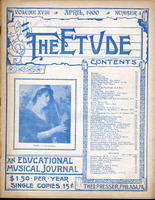BY HELENA M. MAGUIRE.
Reading Between the Staffs.
On glancing carelessly at a sheet of music one receives the impression that all the music is on the staffs, but closer observation proves that that which is between the staffs is just as much music as that which rests directly upon the staffs, and that the little letters, abbreviations, and diverging and converging lines are as truly “musical characters” as the notes, sharps, and fingering directly occupying the staffs. Indeed, the former especially deserve to be called “musical characters,” since they go so far toward shaping the character of the piece.
A girl who would never think of leaving out a note because it happened to be dropped below the staff, often “leaves out” the other characters with gayest unconcern, but she will never be a real “interpreter” until she appreciates the importance of reading between the staffs.
I think my first teacher did me a grave harm in giving me a false idea of what occurred between the staffs. He was a man who had his own ideas as to how things should sound, and would sometimes call out “louder” when between the staffs I read “softer.” If I stopped and pointed to the little “p,” he would say “Oh, a printer’s error. These printers are always making mistakes. Better the other way.” Therefore I grew into a natural belief that, as these marks were not to be trusted, they should be ignored; so ignore them I did, and, as a result, played very badly. One musician said to me: “You start your climaxes so much too soon that your playing is all climax.”
I did not realize what the trouble was until I went to a teacher, who insisted upon my adhering rigidly to the instructions between the lines. This I found irritating, and did not take kindly to it at first, as the “printer’s error” theory still lurked in my belief. But about that time I began to carry the score of the music which I was to hear to every concert which I attended, and, following closely as a Rosenthal or a Carreño interpreted, I came to the quiet, but sincere, conclusion that my errors were glaringly greater than the printer’s.
After that it occurred to me to call the music upon the staff the prose of music, and, that between, the poetry, and just as poetry is more difficult to render effectively than prose, so I found that my “poetry-music” was more difficult than my “prose-music”; but if you try to think of it in this way you will find it very much more interesting than concentrating your attention upon the staffs alone.
Learn your prose well, thoroughly, then look between the staffs and make poetry out of it. Break the even ripples occurring between each bar into great waves of rhythm, toss your accents into light masses of emphasis, and let the quiet valleys between them be low curves of undulating calm, swerving gradually down from the high-piled fortissimos, and as gently ascending on the next crest (or crescendo) of power. Don’t think of printers’ errors; that is nonsense, and but a poor excuse for substituting inferior preferences. Music-printing is very exactly done to-day, and if you carefully follow your printed page you will be more apt to come near to the composer’s intention than if you were to go off on a tangent of your own.



